BIOL121 Worksheet: Human Biology - Semester 2 Assignment
VerifiedAdded on 2023/06/05
|11
|3550
|382
Homework Assignment
AI Summary
This document is a completed worksheet for a BIOL121 Human Biology course, addressing a range of topics. The worksheet includes questions on cell functions, such as melanocytes and Schwann cells, and personal protective equipment for handling urine samples. It further explores the third line of defense comparing B-lymphocytes and Cytotoxic T-lymphocytes, and delves into muscle contraction, the role of osteoblasts and osteoclasts in calcium regulation, and the hypothalamus's control of hormone release from the pituitary gland. Additionally, the worksheet tackles genetic concepts like Duchenne muscular dystrophy, respiratory processes including changes in the chest cavity during exhalation and oxygen dissociation, blood types, and the effects of autonomic innervation on target tissues. The document provides detailed answers and explanations for each question, covering various aspects of human physiology and genetics.
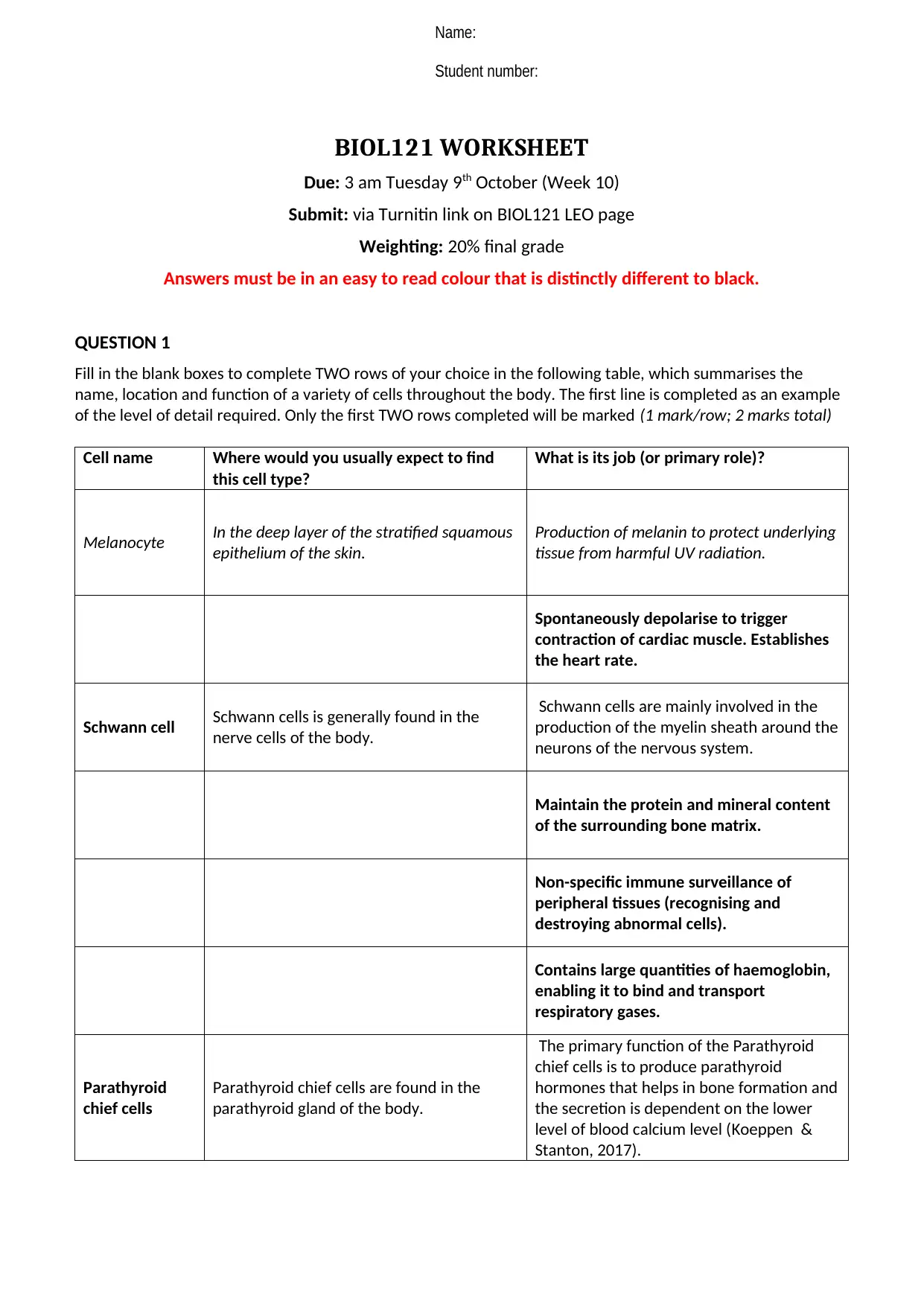
Name:
Student number:
BIOL121 WORKSHEET
Due: 3 am Tuesday 9th October (Week 10)
Submit: via Turnitin link on BIOL121 LEO page
Weighting: 20% final grade
Answers must be in an easy to read colour that is distinctly different to black.
QUESTION 1
Fill in the blank boxes to complete TWO rows of your choice in the following table, which summarises the
name, location and function of a variety of cells throughout the body. The first line is completed as an example
of the level of detail required. Only the first TWO rows completed will be marked (1 mark/row; 2 marks total)
Cell name Where would you usually expect to find
this cell type?
What is its job (or primary role)?
Melanocyte In the deep layer of the stratified squamous
epithelium of the skin.
Production of melanin to protect underlying
tissue from harmful UV radiation.
Spontaneously depolarise to trigger
contraction of cardiac muscle. Establishes
the heart rate.
Schwann cell Schwann cells is generally found in the
nerve cells of the body.
Schwann cells are mainly involved in the
production of the myelin sheath around the
neurons of the nervous system.
Maintain the protein and mineral content
of the surrounding bone matrix.
Non-specific immune surveillance of
peripheral tissues (recognising and
destroying abnormal cells).
Contains large quantities of haemoglobin,
enabling it to bind and transport
respiratory gases.
Parathyroid
chief cells
Parathyroid chief cells are found in the
parathyroid gland of the body.
The primary function of the Parathyroid
chief cells is to produce parathyroid
hormones that helps in bone formation and
the secretion is dependent on the lower
level of blood calcium level (Koeppen &
Stanton, 2017).
Student number:
BIOL121 WORKSHEET
Due: 3 am Tuesday 9th October (Week 10)
Submit: via Turnitin link on BIOL121 LEO page
Weighting: 20% final grade
Answers must be in an easy to read colour that is distinctly different to black.
QUESTION 1
Fill in the blank boxes to complete TWO rows of your choice in the following table, which summarises the
name, location and function of a variety of cells throughout the body. The first line is completed as an example
of the level of detail required. Only the first TWO rows completed will be marked (1 mark/row; 2 marks total)
Cell name Where would you usually expect to find
this cell type?
What is its job (or primary role)?
Melanocyte In the deep layer of the stratified squamous
epithelium of the skin.
Production of melanin to protect underlying
tissue from harmful UV radiation.
Spontaneously depolarise to trigger
contraction of cardiac muscle. Establishes
the heart rate.
Schwann cell Schwann cells is generally found in the
nerve cells of the body.
Schwann cells are mainly involved in the
production of the myelin sheath around the
neurons of the nervous system.
Maintain the protein and mineral content
of the surrounding bone matrix.
Non-specific immune surveillance of
peripheral tissues (recognising and
destroying abnormal cells).
Contains large quantities of haemoglobin,
enabling it to bind and transport
respiratory gases.
Parathyroid
chief cells
Parathyroid chief cells are found in the
parathyroid gland of the body.
The primary function of the Parathyroid
chief cells is to produce parathyroid
hormones that helps in bone formation and
the secretion is dependent on the lower
level of blood calcium level (Koeppen &
Stanton, 2017).
Secure Best Marks with AI Grader
Need help grading? Try our AI Grader for instant feedback on your assignments.
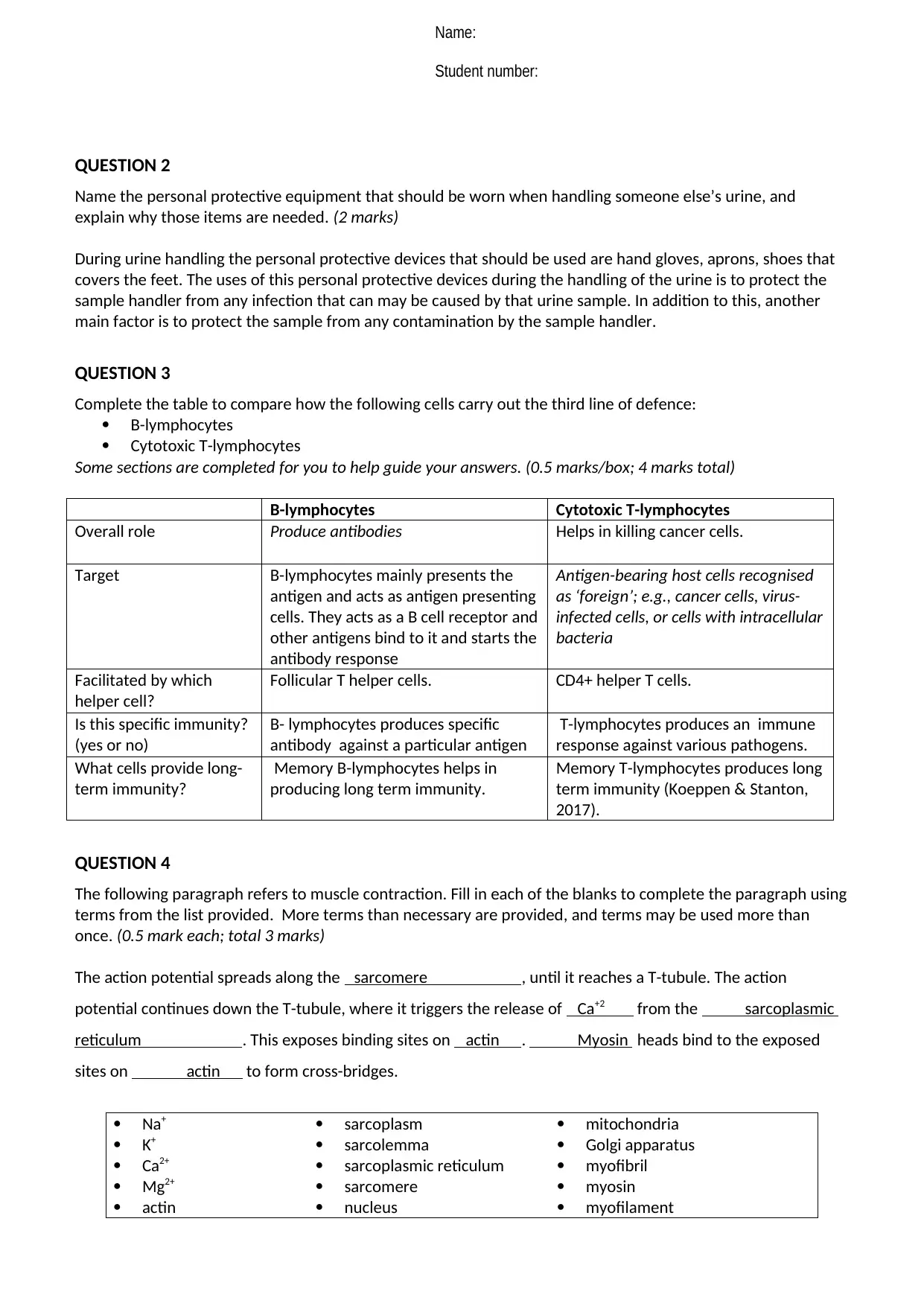
Name:
Student number:
QUESTION 2
Name the personal protective equipment that should be worn when handling someone else’s urine, and
explain why those items are needed. (2 marks)
During urine handling the personal protective devices that should be used are hand gloves, aprons, shoes that
covers the feet. The uses of this personal protective devices during the handling of the urine is to protect the
sample handler from any infection that can may be caused by that urine sample. In addition to this, another
main factor is to protect the sample from any contamination by the sample handler.
QUESTION 3
Complete the table to compare how the following cells carry out the third line of defence:
B-lymphocytes
Cytotoxic T-lymphocytes
Some sections are completed for you to help guide your answers. (0.5 marks/box; 4 marks total)
B-lymphocytes Cytotoxic T-lymphocytes
Overall role Produce antibodies Helps in killing cancer cells.
Target B-lymphocytes mainly presents the
antigen and acts as antigen presenting
cells. They acts as a B cell receptor and
other antigens bind to it and starts the
antibody response
Antigen-bearing host cells recognised
as ‘foreign’; e.g., cancer cells, virus-
infected cells, or cells with intracellular
bacteria
Facilitated by which
helper cell?
Follicular T helper cells. CD4+ helper T cells.
Is this specific immunity?
(yes or no)
B- lymphocytes produces specific
antibody against a particular antigen
T-lymphocytes produces an immune
response against various pathogens.
What cells provide long-
term immunity?
Memory B-lymphocytes helps in
producing long term immunity.
Memory T-lymphocytes produces long
term immunity (Koeppen & Stanton,
2017).
QUESTION 4
The following paragraph refers to muscle contraction. Fill in each of the blanks to complete the paragraph using
terms from the list provided. More terms than necessary are provided, and terms may be used more than
once. (0.5 mark each; total 3 marks)
The action potential spreads along the sarcomere , until it reaches a T-tubule. The action
potential continues down the T-tubule, where it triggers the release of Ca+2 from the sarcoplasmic
reticulum . This exposes binding sites on actin . Myosin heads bind to the exposed
sites on actin to form cross-bridges.
Na+ sarcoplasm mitochondria
K+ sarcolemma Golgi apparatus
Ca2+
Mg2+
sarcoplasmic reticulum
sarcomere
myofibril
myosin
actin nucleus myofilament
Student number:
QUESTION 2
Name the personal protective equipment that should be worn when handling someone else’s urine, and
explain why those items are needed. (2 marks)
During urine handling the personal protective devices that should be used are hand gloves, aprons, shoes that
covers the feet. The uses of this personal protective devices during the handling of the urine is to protect the
sample handler from any infection that can may be caused by that urine sample. In addition to this, another
main factor is to protect the sample from any contamination by the sample handler.
QUESTION 3
Complete the table to compare how the following cells carry out the third line of defence:
B-lymphocytes
Cytotoxic T-lymphocytes
Some sections are completed for you to help guide your answers. (0.5 marks/box; 4 marks total)
B-lymphocytes Cytotoxic T-lymphocytes
Overall role Produce antibodies Helps in killing cancer cells.
Target B-lymphocytes mainly presents the
antigen and acts as antigen presenting
cells. They acts as a B cell receptor and
other antigens bind to it and starts the
antibody response
Antigen-bearing host cells recognised
as ‘foreign’; e.g., cancer cells, virus-
infected cells, or cells with intracellular
bacteria
Facilitated by which
helper cell?
Follicular T helper cells. CD4+ helper T cells.
Is this specific immunity?
(yes or no)
B- lymphocytes produces specific
antibody against a particular antigen
T-lymphocytes produces an immune
response against various pathogens.
What cells provide long-
term immunity?
Memory B-lymphocytes helps in
producing long term immunity.
Memory T-lymphocytes produces long
term immunity (Koeppen & Stanton,
2017).
QUESTION 4
The following paragraph refers to muscle contraction. Fill in each of the blanks to complete the paragraph using
terms from the list provided. More terms than necessary are provided, and terms may be used more than
once. (0.5 mark each; total 3 marks)
The action potential spreads along the sarcomere , until it reaches a T-tubule. The action
potential continues down the T-tubule, where it triggers the release of Ca+2 from the sarcoplasmic
reticulum . This exposes binding sites on actin . Myosin heads bind to the exposed
sites on actin to form cross-bridges.
Na+ sarcoplasm mitochondria
K+ sarcolemma Golgi apparatus
Ca2+
Mg2+
sarcoplasmic reticulum
sarcomere
myofibril
myosin
actin nucleus myofilament
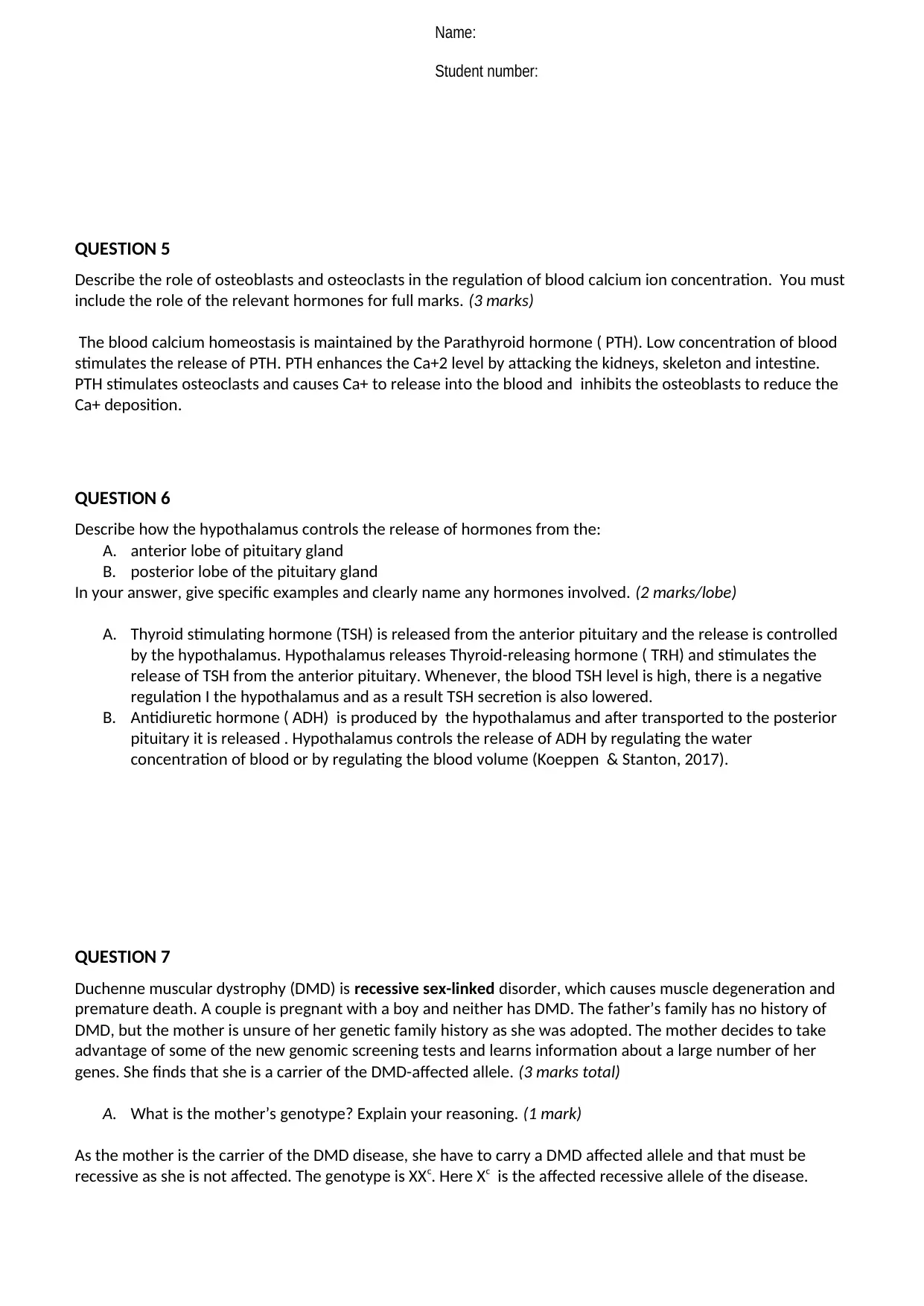
Name:
Student number:
QUESTION 5
Describe the role of osteoblasts and osteoclasts in the regulation of blood calcium ion concentration. You must
include the role of the relevant hormones for full marks. (3 marks)
The blood calcium homeostasis is maintained by the Parathyroid hormone ( PTH). Low concentration of blood
stimulates the release of PTH. PTH enhances the Ca+2 level by attacking the kidneys, skeleton and intestine.
PTH stimulates osteoclasts and causes Ca+ to release into the blood and inhibits the osteoblasts to reduce the
Ca+ deposition.
QUESTION 6
Describe how the hypothalamus controls the release of hormones from the:
A. anterior lobe of pituitary gland
B. posterior lobe of the pituitary gland
In your answer, give specific examples and clearly name any hormones involved. (2 marks/lobe)
A. Thyroid stimulating hormone (TSH) is released from the anterior pituitary and the release is controlled
by the hypothalamus. Hypothalamus releases Thyroid-releasing hormone ( TRH) and stimulates the
release of TSH from the anterior pituitary. Whenever, the blood TSH level is high, there is a negative
regulation I the hypothalamus and as a result TSH secretion is also lowered.
B. Antidiuretic hormone ( ADH) is produced by the hypothalamus and after transported to the posterior
pituitary it is released . Hypothalamus controls the release of ADH by regulating the water
concentration of blood or by regulating the blood volume (Koeppen & Stanton, 2017).
QUESTION 7
Duchenne muscular dystrophy (DMD) is recessive sex-linked disorder, which causes muscle degeneration and
premature death. A couple is pregnant with a boy and neither has DMD. The father’s family has no history of
DMD, but the mother is unsure of her genetic family history as she was adopted. The mother decides to take
advantage of some of the new genomic screening tests and learns information about a large number of her
genes. She finds that she is a carrier of the DMD-affected allele. (3 marks total)
A. What is the mother’s genotype? Explain your reasoning. (1 mark)
As the mother is the carrier of the DMD disease, she have to carry a DMD affected allele and that must be
recessive as she is not affected. The genotype is XXc. Here Xc is the affected recessive allele of the disease.
Student number:
QUESTION 5
Describe the role of osteoblasts and osteoclasts in the regulation of blood calcium ion concentration. You must
include the role of the relevant hormones for full marks. (3 marks)
The blood calcium homeostasis is maintained by the Parathyroid hormone ( PTH). Low concentration of blood
stimulates the release of PTH. PTH enhances the Ca+2 level by attacking the kidneys, skeleton and intestine.
PTH stimulates osteoclasts and causes Ca+ to release into the blood and inhibits the osteoblasts to reduce the
Ca+ deposition.
QUESTION 6
Describe how the hypothalamus controls the release of hormones from the:
A. anterior lobe of pituitary gland
B. posterior lobe of the pituitary gland
In your answer, give specific examples and clearly name any hormones involved. (2 marks/lobe)
A. Thyroid stimulating hormone (TSH) is released from the anterior pituitary and the release is controlled
by the hypothalamus. Hypothalamus releases Thyroid-releasing hormone ( TRH) and stimulates the
release of TSH from the anterior pituitary. Whenever, the blood TSH level is high, there is a negative
regulation I the hypothalamus and as a result TSH secretion is also lowered.
B. Antidiuretic hormone ( ADH) is produced by the hypothalamus and after transported to the posterior
pituitary it is released . Hypothalamus controls the release of ADH by regulating the water
concentration of blood or by regulating the blood volume (Koeppen & Stanton, 2017).
QUESTION 7
Duchenne muscular dystrophy (DMD) is recessive sex-linked disorder, which causes muscle degeneration and
premature death. A couple is pregnant with a boy and neither has DMD. The father’s family has no history of
DMD, but the mother is unsure of her genetic family history as she was adopted. The mother decides to take
advantage of some of the new genomic screening tests and learns information about a large number of her
genes. She finds that she is a carrier of the DMD-affected allele. (3 marks total)
A. What is the mother’s genotype? Explain your reasoning. (1 mark)
As the mother is the carrier of the DMD disease, she have to carry a DMD affected allele and that must be
recessive as she is not affected. The genotype is XXc. Here Xc is the affected recessive allele of the disease.
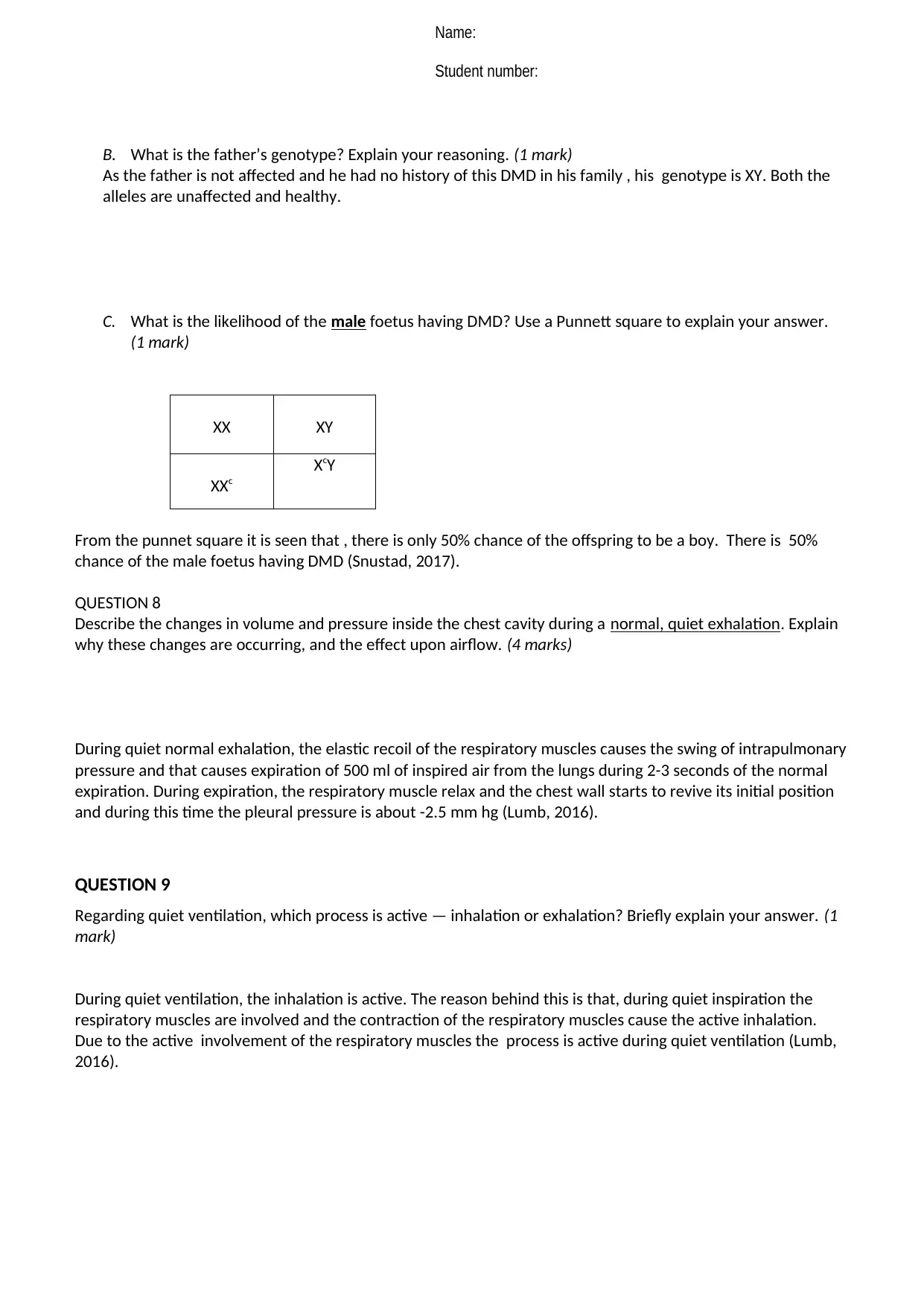
Name:
Student number:
B. What is the father’s genotype? Explain your reasoning. (1 mark)
As the father is not affected and he had no history of this DMD in his family , his genotype is XY. Both the
alleles are unaffected and healthy.
C. What is the likelihood of the male foetus having DMD? Use a Punnett square to explain your answer.
(1 mark)
XX XY
XXc
XcY
From the punnet square it is seen that , there is only 50% chance of the offspring to be a boy. There is 50%
chance of the male foetus having DMD (Snustad, 2017).
QUESTION 8
Describe the changes in volume and pressure inside the chest cavity during a normal, quiet exhalation. Explain
why these changes are occurring, and the effect upon airflow. (4 marks)
During quiet normal exhalation, the elastic recoil of the respiratory muscles causes the swing of intrapulmonary
pressure and that causes expiration of 500 ml of inspired air from the lungs during 2-3 seconds of the normal
expiration. During expiration, the respiratory muscle relax and the chest wall starts to revive its initial position
and during this time the pleural pressure is about -2.5 mm hg (Lumb, 2016).
QUESTION 9
Regarding quiet ventilation, which process is active — inhalation or exhalation? Briefly explain your answer. (1
mark)
During quiet ventilation, the inhalation is active. The reason behind this is that, during quiet inspiration the
respiratory muscles are involved and the contraction of the respiratory muscles cause the active inhalation.
Due to the active involvement of the respiratory muscles the process is active during quiet ventilation (Lumb,
2016).
Student number:
B. What is the father’s genotype? Explain your reasoning. (1 mark)
As the father is not affected and he had no history of this DMD in his family , his genotype is XY. Both the
alleles are unaffected and healthy.
C. What is the likelihood of the male foetus having DMD? Use a Punnett square to explain your answer.
(1 mark)
XX XY
XXc
XcY
From the punnet square it is seen that , there is only 50% chance of the offspring to be a boy. There is 50%
chance of the male foetus having DMD (Snustad, 2017).
QUESTION 8
Describe the changes in volume and pressure inside the chest cavity during a normal, quiet exhalation. Explain
why these changes are occurring, and the effect upon airflow. (4 marks)
During quiet normal exhalation, the elastic recoil of the respiratory muscles causes the swing of intrapulmonary
pressure and that causes expiration of 500 ml of inspired air from the lungs during 2-3 seconds of the normal
expiration. During expiration, the respiratory muscle relax and the chest wall starts to revive its initial position
and during this time the pleural pressure is about -2.5 mm hg (Lumb, 2016).
QUESTION 9
Regarding quiet ventilation, which process is active — inhalation or exhalation? Briefly explain your answer. (1
mark)
During quiet ventilation, the inhalation is active. The reason behind this is that, during quiet inspiration the
respiratory muscles are involved and the contraction of the respiratory muscles cause the active inhalation.
Due to the active involvement of the respiratory muscles the process is active during quiet ventilation (Lumb,
2016).
Secure Best Marks with AI Grader
Need help grading? Try our AI Grader for instant feedback on your assignments.
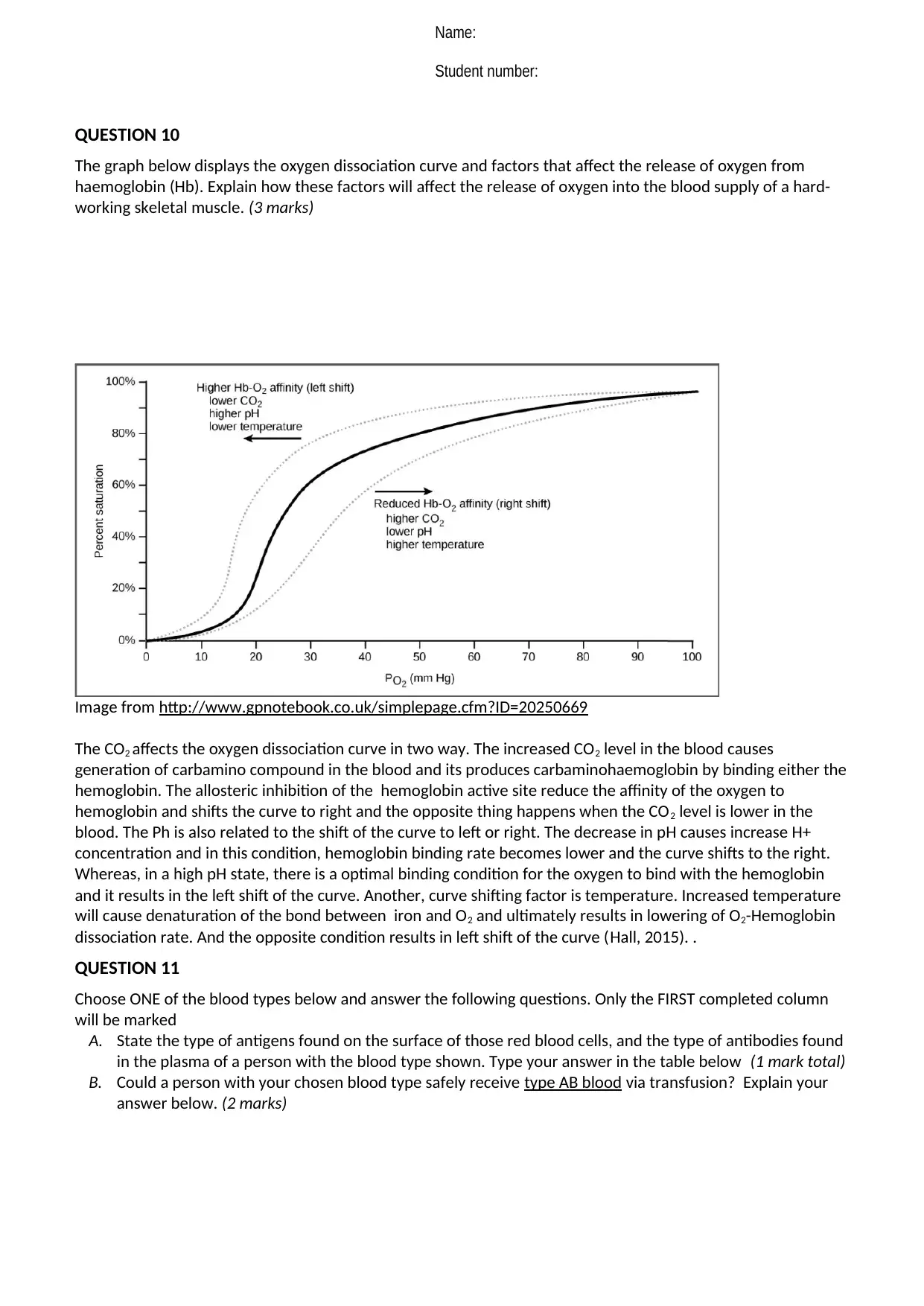
Name:
Student number:
QUESTION 10
The graph below displays the oxygen dissociation curve and factors that affect the release of oxygen from
haemoglobin (Hb). Explain how these factors will affect the release of oxygen into the blood supply of a hard-
working skeletal muscle. (3 marks)
Image from http://www.gpnotebook.co.uk/simplepage.cfm?ID=20250669
The CO2 affects the oxygen dissociation curve in two way. The increased CO2 level in the blood causes
generation of carbamino compound in the blood and its produces carbaminohaemoglobin by binding either the
hemoglobin. The allosteric inhibition of the hemoglobin active site reduce the affinity of the oxygen to
hemoglobin and shifts the curve to right and the opposite thing happens when the CO2 level is lower in the
blood. The Ph is also related to the shift of the curve to left or right. The decrease in pH causes increase H+
concentration and in this condition, hemoglobin binding rate becomes lower and the curve shifts to the right.
Whereas, in a high pH state, there is a optimal binding condition for the oxygen to bind with the hemoglobin
and it results in the left shift of the curve. Another, curve shifting factor is temperature. Increased temperature
will cause denaturation of the bond between iron and O2 and ultimately results in lowering of O2-Hemoglobin
dissociation rate. And the opposite condition results in left shift of the curve (Hall, 2015). .
QUESTION 11
Choose ONE of the blood types below and answer the following questions. Only the FIRST completed column
will be marked
A. State the type of antigens found on the surface of those red blood cells, and the type of antibodies found
in the plasma of a person with the blood type shown. Type your answer in the table below (1 mark total)
B. Could a person with your chosen blood type safely receive type AB blood via transfusion? Explain your
answer below. (2 marks)
Student number:
QUESTION 10
The graph below displays the oxygen dissociation curve and factors that affect the release of oxygen from
haemoglobin (Hb). Explain how these factors will affect the release of oxygen into the blood supply of a hard-
working skeletal muscle. (3 marks)
Image from http://www.gpnotebook.co.uk/simplepage.cfm?ID=20250669
The CO2 affects the oxygen dissociation curve in two way. The increased CO2 level in the blood causes
generation of carbamino compound in the blood and its produces carbaminohaemoglobin by binding either the
hemoglobin. The allosteric inhibition of the hemoglobin active site reduce the affinity of the oxygen to
hemoglobin and shifts the curve to right and the opposite thing happens when the CO2 level is lower in the
blood. The Ph is also related to the shift of the curve to left or right. The decrease in pH causes increase H+
concentration and in this condition, hemoglobin binding rate becomes lower and the curve shifts to the right.
Whereas, in a high pH state, there is a optimal binding condition for the oxygen to bind with the hemoglobin
and it results in the left shift of the curve. Another, curve shifting factor is temperature. Increased temperature
will cause denaturation of the bond between iron and O2 and ultimately results in lowering of O2-Hemoglobin
dissociation rate. And the opposite condition results in left shift of the curve (Hall, 2015). .
QUESTION 11
Choose ONE of the blood types below and answer the following questions. Only the FIRST completed column
will be marked
A. State the type of antigens found on the surface of those red blood cells, and the type of antibodies found
in the plasma of a person with the blood type shown. Type your answer in the table below (1 mark total)
B. Could a person with your chosen blood type safely receive type AB blood via transfusion? Explain your
answer below. (2 marks)
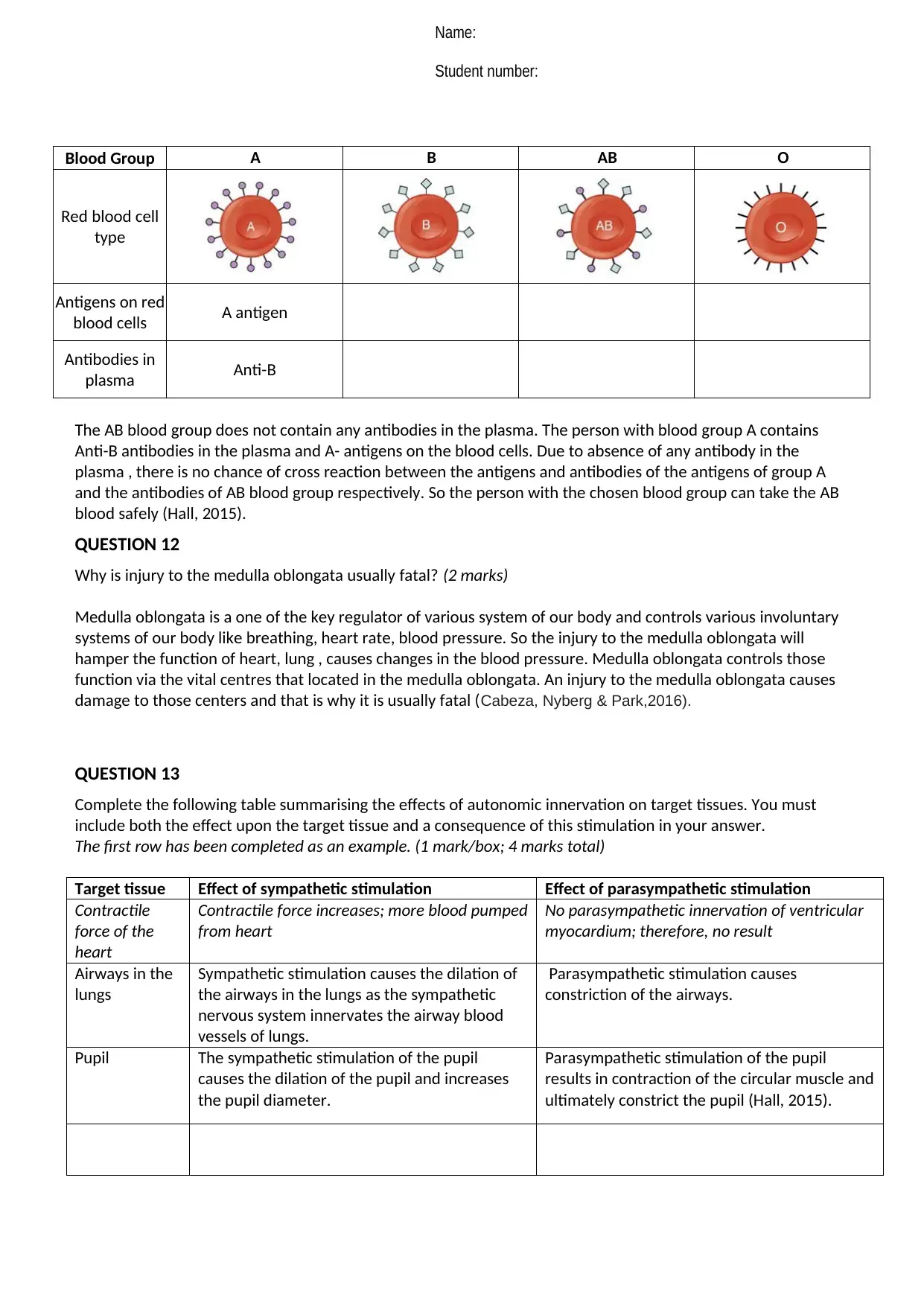
Name:
Student number:
Blood Group A B AB O
Red blood cell
type
Antigens on red
blood cells A antigen
Antibodies in
plasma Anti-B
The AB blood group does not contain any antibodies in the plasma. The person with blood group A contains
Anti-B antibodies in the plasma and A- antigens on the blood cells. Due to absence of any antibody in the
plasma , there is no chance of cross reaction between the antigens and antibodies of the antigens of group A
and the antibodies of AB blood group respectively. So the person with the chosen blood group can take the AB
blood safely (Hall, 2015).
QUESTION 12
Why is injury to the medulla oblongata usually fatal? (2 marks)
Medulla oblongata is a one of the key regulator of various system of our body and controls various involuntary
systems of our body like breathing, heart rate, blood pressure. So the injury to the medulla oblongata will
hamper the function of heart, lung , causes changes in the blood pressure. Medulla oblongata controls those
function via the vital centres that located in the medulla oblongata. An injury to the medulla oblongata causes
damage to those centers and that is why it is usually fatal (Cabeza, Nyberg & Park,2016).
QUESTION 13
Complete the following table summarising the effects of autonomic innervation on target tissues. You must
include both the effect upon the target tissue and a consequence of this stimulation in your answer.
The first row has been completed as an example. (1 mark/box; 4 marks total)
Target tissue Effect of sympathetic stimulation Effect of parasympathetic stimulation
Contractile
force of the
heart
Contractile force increases; more blood pumped
from heart
No parasympathetic innervation of ventricular
myocardium; therefore, no result
Airways in the
lungs
Sympathetic stimulation causes the dilation of
the airways in the lungs as the sympathetic
nervous system innervates the airway blood
vessels of lungs.
Parasympathetic stimulation causes
constriction of the airways.
Pupil The sympathetic stimulation of the pupil
causes the dilation of the pupil and increases
the pupil diameter.
Parasympathetic stimulation of the pupil
results in contraction of the circular muscle and
ultimately constrict the pupil (Hall, 2015).
Student number:
Blood Group A B AB O
Red blood cell
type
Antigens on red
blood cells A antigen
Antibodies in
plasma Anti-B
The AB blood group does not contain any antibodies in the plasma. The person with blood group A contains
Anti-B antibodies in the plasma and A- antigens on the blood cells. Due to absence of any antibody in the
plasma , there is no chance of cross reaction between the antigens and antibodies of the antigens of group A
and the antibodies of AB blood group respectively. So the person with the chosen blood group can take the AB
blood safely (Hall, 2015).
QUESTION 12
Why is injury to the medulla oblongata usually fatal? (2 marks)
Medulla oblongata is a one of the key regulator of various system of our body and controls various involuntary
systems of our body like breathing, heart rate, blood pressure. So the injury to the medulla oblongata will
hamper the function of heart, lung , causes changes in the blood pressure. Medulla oblongata controls those
function via the vital centres that located in the medulla oblongata. An injury to the medulla oblongata causes
damage to those centers and that is why it is usually fatal (Cabeza, Nyberg & Park,2016).
QUESTION 13
Complete the following table summarising the effects of autonomic innervation on target tissues. You must
include both the effect upon the target tissue and a consequence of this stimulation in your answer.
The first row has been completed as an example. (1 mark/box; 4 marks total)
Target tissue Effect of sympathetic stimulation Effect of parasympathetic stimulation
Contractile
force of the
heart
Contractile force increases; more blood pumped
from heart
No parasympathetic innervation of ventricular
myocardium; therefore, no result
Airways in the
lungs
Sympathetic stimulation causes the dilation of
the airways in the lungs as the sympathetic
nervous system innervates the airway blood
vessels of lungs.
Parasympathetic stimulation causes
constriction of the airways.
Pupil The sympathetic stimulation of the pupil
causes the dilation of the pupil and increases
the pupil diameter.
Parasympathetic stimulation of the pupil
results in contraction of the circular muscle and
ultimately constrict the pupil (Hall, 2015).
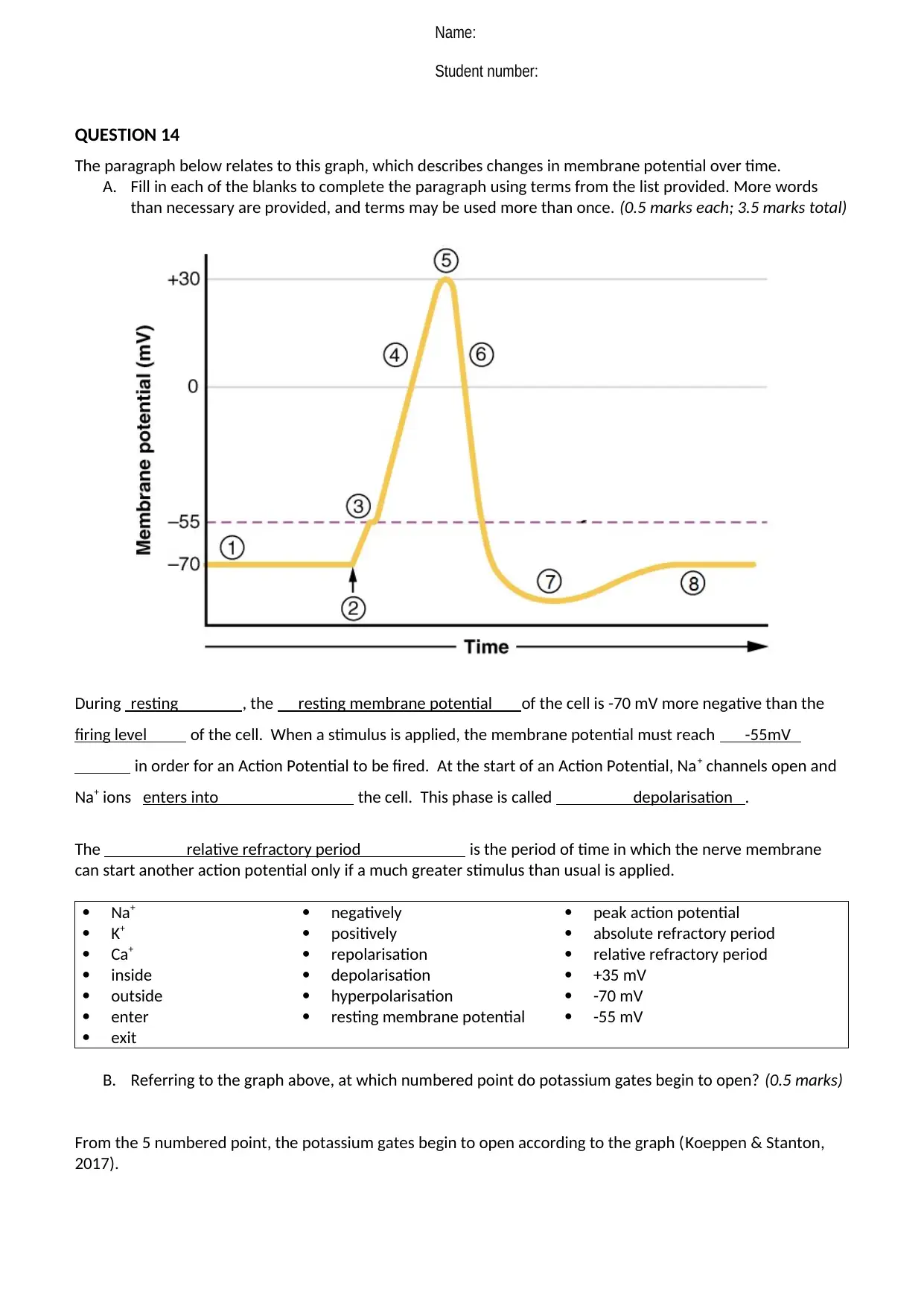
Name:
Student number:
QUESTION 14
The paragraph below relates to this graph, which describes changes in membrane potential over time.
A. Fill in each of the blanks to complete the paragraph using terms from the list provided. More words
than necessary are provided, and terms may be used more than once. (0.5 marks each; 3.5 marks total)
During resting , the resting membrane potential of the cell is -70 mV more negative than the
firing level of the cell. When a stimulus is applied, the membrane potential must reach -55mV
in order for an Action Potential to be fired. At the start of an Action Potential, Na+ channels open and
Na+ ions enters into the cell. This phase is called depolarisation .
The relative refractory period is the period of time in which the nerve membrane
can start another action potential only if a much greater stimulus than usual is applied.
Na+ negatively peak action potential
K+ positively absolute refractory period
Ca+ repolarisation relative refractory period
inside depolarisation +35 mV
outside
enter
exit
hyperpolarisation
resting membrane potential
-70 mV
-55 mV
B. Referring to the graph above, at which numbered point do potassium gates begin to open? (0.5 marks)
From the 5 numbered point, the potassium gates begin to open according to the graph (Koeppen & Stanton,
2017).
Student number:
QUESTION 14
The paragraph below relates to this graph, which describes changes in membrane potential over time.
A. Fill in each of the blanks to complete the paragraph using terms from the list provided. More words
than necessary are provided, and terms may be used more than once. (0.5 marks each; 3.5 marks total)
During resting , the resting membrane potential of the cell is -70 mV more negative than the
firing level of the cell. When a stimulus is applied, the membrane potential must reach -55mV
in order for an Action Potential to be fired. At the start of an Action Potential, Na+ channels open and
Na+ ions enters into the cell. This phase is called depolarisation .
The relative refractory period is the period of time in which the nerve membrane
can start another action potential only if a much greater stimulus than usual is applied.
Na+ negatively peak action potential
K+ positively absolute refractory period
Ca+ repolarisation relative refractory period
inside depolarisation +35 mV
outside
enter
exit
hyperpolarisation
resting membrane potential
-70 mV
-55 mV
B. Referring to the graph above, at which numbered point do potassium gates begin to open? (0.5 marks)
From the 5 numbered point, the potassium gates begin to open according to the graph (Koeppen & Stanton,
2017).
Paraphrase This Document
Need a fresh take? Get an instant paraphrase of this document with our AI Paraphraser
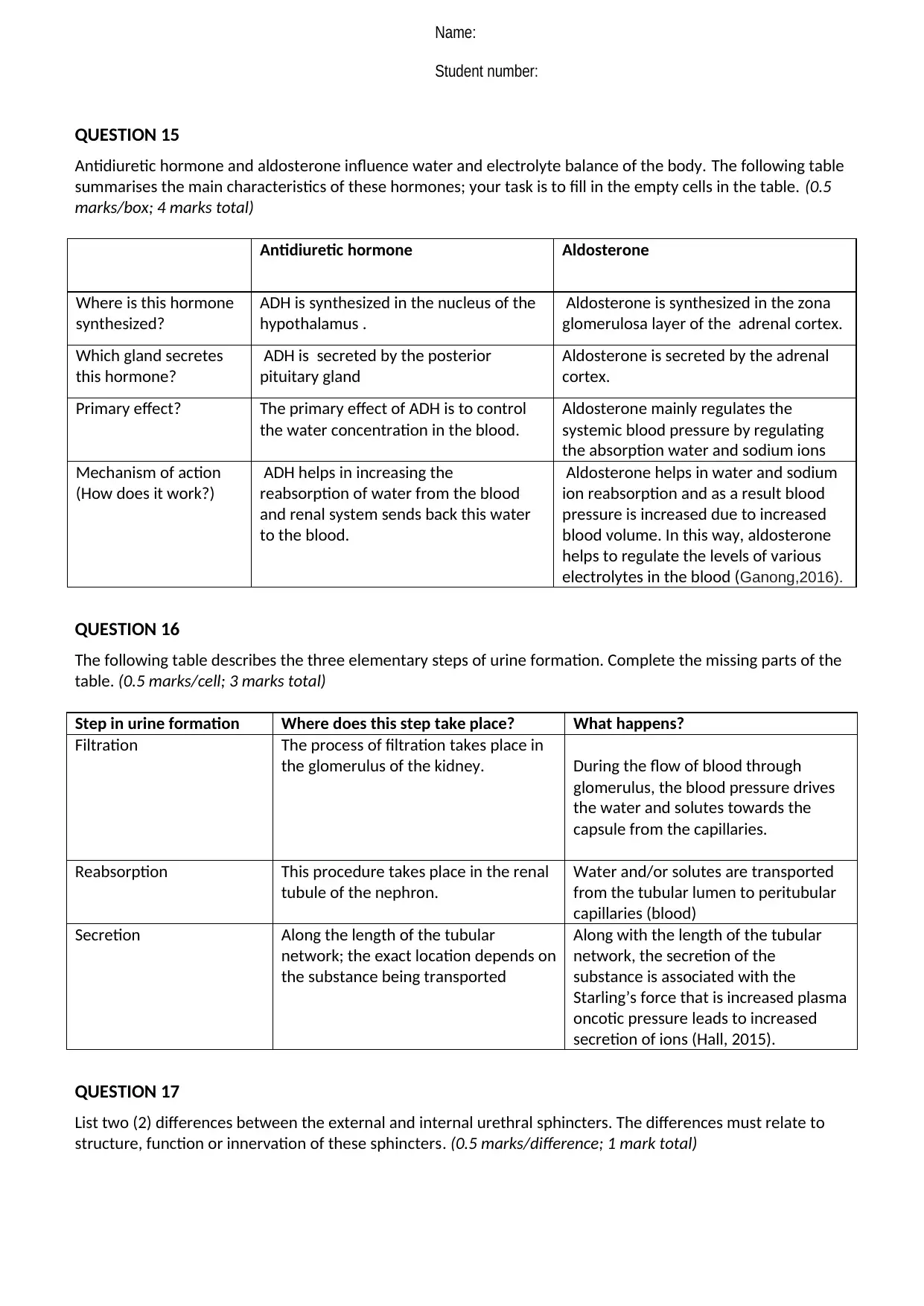
Name:
Student number:
QUESTION 15
Antidiuretic hormone and aldosterone influence water and electrolyte balance of the body. The following table
summarises the main characteristics of these hormones; your task is to fill in the empty cells in the table. (0.5
marks/box; 4 marks total)
Antidiuretic hormone Aldosterone
Where is this hormone
synthesized?
ADH is synthesized in the nucleus of the
hypothalamus .
Aldosterone is synthesized in the zona
glomerulosa layer of the adrenal cortex.
Which gland secretes
this hormone?
ADH is secreted by the posterior
pituitary gland
Aldosterone is secreted by the adrenal
cortex.
Primary effect? The primary effect of ADH is to control
the water concentration in the blood.
Aldosterone mainly regulates the
systemic blood pressure by regulating
the absorption water and sodium ions
Mechanism of action
(How does it work?)
ADH helps in increasing the
reabsorption of water from the blood
and renal system sends back this water
to the blood.
Aldosterone helps in water and sodium
ion reabsorption and as a result blood
pressure is increased due to increased
blood volume. In this way, aldosterone
helps to regulate the levels of various
electrolytes in the blood (Ganong,2016).
QUESTION 16
The following table describes the three elementary steps of urine formation. Complete the missing parts of the
table. (0.5 marks/cell; 3 marks total)
Step in urine formation Where does this step take place? What happens?
Filtration The process of filtration takes place in
the glomerulus of the kidney. During the flow of blood through
glomerulus, the blood pressure drives
the water and solutes towards the
capsule from the capillaries.
Reabsorption This procedure takes place in the renal
tubule of the nephron.
Water and/or solutes are transported
from the tubular lumen to peritubular
capillaries (blood)
Secretion Along the length of the tubular
network; the exact location depends on
the substance being transported
Along with the length of the tubular
network, the secretion of the
substance is associated with the
Starling’s force that is increased plasma
oncotic pressure leads to increased
secretion of ions (Hall, 2015).
QUESTION 17
List two (2) differences between the external and internal urethral sphincters. The differences must relate to
structure, function or innervation of these sphincters. (0.5 marks/difference; 1 mark total)
Student number:
QUESTION 15
Antidiuretic hormone and aldosterone influence water and electrolyte balance of the body. The following table
summarises the main characteristics of these hormones; your task is to fill in the empty cells in the table. (0.5
marks/box; 4 marks total)
Antidiuretic hormone Aldosterone
Where is this hormone
synthesized?
ADH is synthesized in the nucleus of the
hypothalamus .
Aldosterone is synthesized in the zona
glomerulosa layer of the adrenal cortex.
Which gland secretes
this hormone?
ADH is secreted by the posterior
pituitary gland
Aldosterone is secreted by the adrenal
cortex.
Primary effect? The primary effect of ADH is to control
the water concentration in the blood.
Aldosterone mainly regulates the
systemic blood pressure by regulating
the absorption water and sodium ions
Mechanism of action
(How does it work?)
ADH helps in increasing the
reabsorption of water from the blood
and renal system sends back this water
to the blood.
Aldosterone helps in water and sodium
ion reabsorption and as a result blood
pressure is increased due to increased
blood volume. In this way, aldosterone
helps to regulate the levels of various
electrolytes in the blood (Ganong,2016).
QUESTION 16
The following table describes the three elementary steps of urine formation. Complete the missing parts of the
table. (0.5 marks/cell; 3 marks total)
Step in urine formation Where does this step take place? What happens?
Filtration The process of filtration takes place in
the glomerulus of the kidney. During the flow of blood through
glomerulus, the blood pressure drives
the water and solutes towards the
capsule from the capillaries.
Reabsorption This procedure takes place in the renal
tubule of the nephron.
Water and/or solutes are transported
from the tubular lumen to peritubular
capillaries (blood)
Secretion Along the length of the tubular
network; the exact location depends on
the substance being transported
Along with the length of the tubular
network, the secretion of the
substance is associated with the
Starling’s force that is increased plasma
oncotic pressure leads to increased
secretion of ions (Hall, 2015).
QUESTION 17
List two (2) differences between the external and internal urethral sphincters. The differences must relate to
structure, function or innervation of these sphincters. (0.5 marks/difference; 1 mark total)
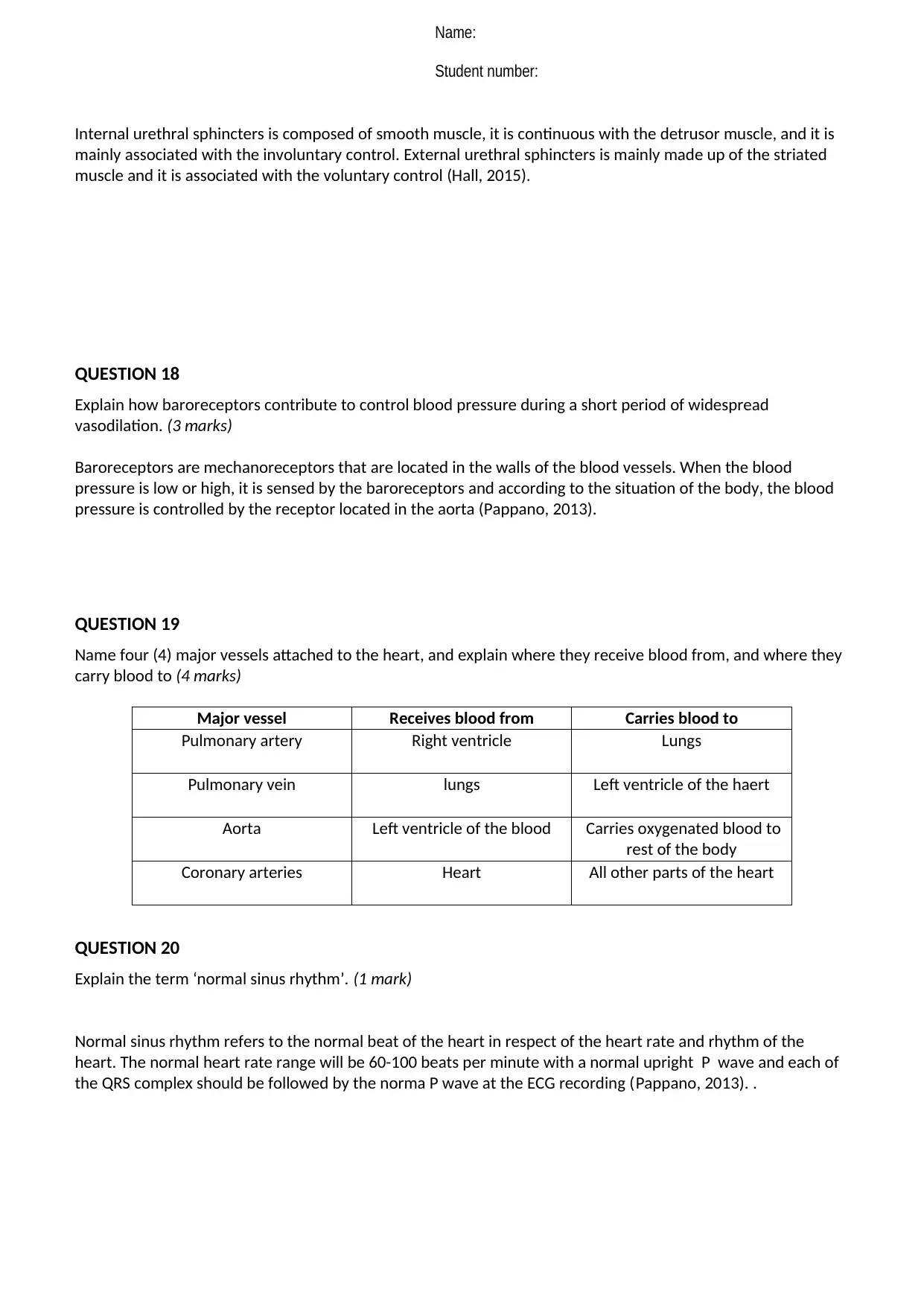
Name:
Student number:
Internal urethral sphincters is composed of smooth muscle, it is continuous with the detrusor muscle, and it is
mainly associated with the involuntary control. External urethral sphincters is mainly made up of the striated
muscle and it is associated with the voluntary control (Hall, 2015).
QUESTION 18
Explain how baroreceptors contribute to control blood pressure during a short period of widespread
vasodilation. (3 marks)
Baroreceptors are mechanoreceptors that are located in the walls of the blood vessels. When the blood
pressure is low or high, it is sensed by the baroreceptors and according to the situation of the body, the blood
pressure is controlled by the receptor located in the aorta (Pappano, 2013).
QUESTION 19
Name four (4) major vessels attached to the heart, and explain where they receive blood from, and where they
carry blood to (4 marks)
Major vessel Receives blood from Carries blood to
Pulmonary artery Right ventricle Lungs
Pulmonary vein lungs Left ventricle of the haert
Aorta Left ventricle of the blood Carries oxygenated blood to
rest of the body
Coronary arteries Heart All other parts of the heart
QUESTION 20
Explain the term ‘normal sinus rhythm’. (1 mark)
Normal sinus rhythm refers to the normal beat of the heart in respect of the heart rate and rhythm of the
heart. The normal heart rate range will be 60-100 beats per minute with a normal upright P wave and each of
the QRS complex should be followed by the norma P wave at the ECG recording (Pappano, 2013). .
Student number:
Internal urethral sphincters is composed of smooth muscle, it is continuous with the detrusor muscle, and it is
mainly associated with the involuntary control. External urethral sphincters is mainly made up of the striated
muscle and it is associated with the voluntary control (Hall, 2015).
QUESTION 18
Explain how baroreceptors contribute to control blood pressure during a short period of widespread
vasodilation. (3 marks)
Baroreceptors are mechanoreceptors that are located in the walls of the blood vessels. When the blood
pressure is low or high, it is sensed by the baroreceptors and according to the situation of the body, the blood
pressure is controlled by the receptor located in the aorta (Pappano, 2013).
QUESTION 19
Name four (4) major vessels attached to the heart, and explain where they receive blood from, and where they
carry blood to (4 marks)
Major vessel Receives blood from Carries blood to
Pulmonary artery Right ventricle Lungs
Pulmonary vein lungs Left ventricle of the haert
Aorta Left ventricle of the blood Carries oxygenated blood to
rest of the body
Coronary arteries Heart All other parts of the heart
QUESTION 20
Explain the term ‘normal sinus rhythm’. (1 mark)
Normal sinus rhythm refers to the normal beat of the heart in respect of the heart rate and rhythm of the
heart. The normal heart rate range will be 60-100 beats per minute with a normal upright P wave and each of
the QRS complex should be followed by the norma P wave at the ECG recording (Pappano, 2013). .
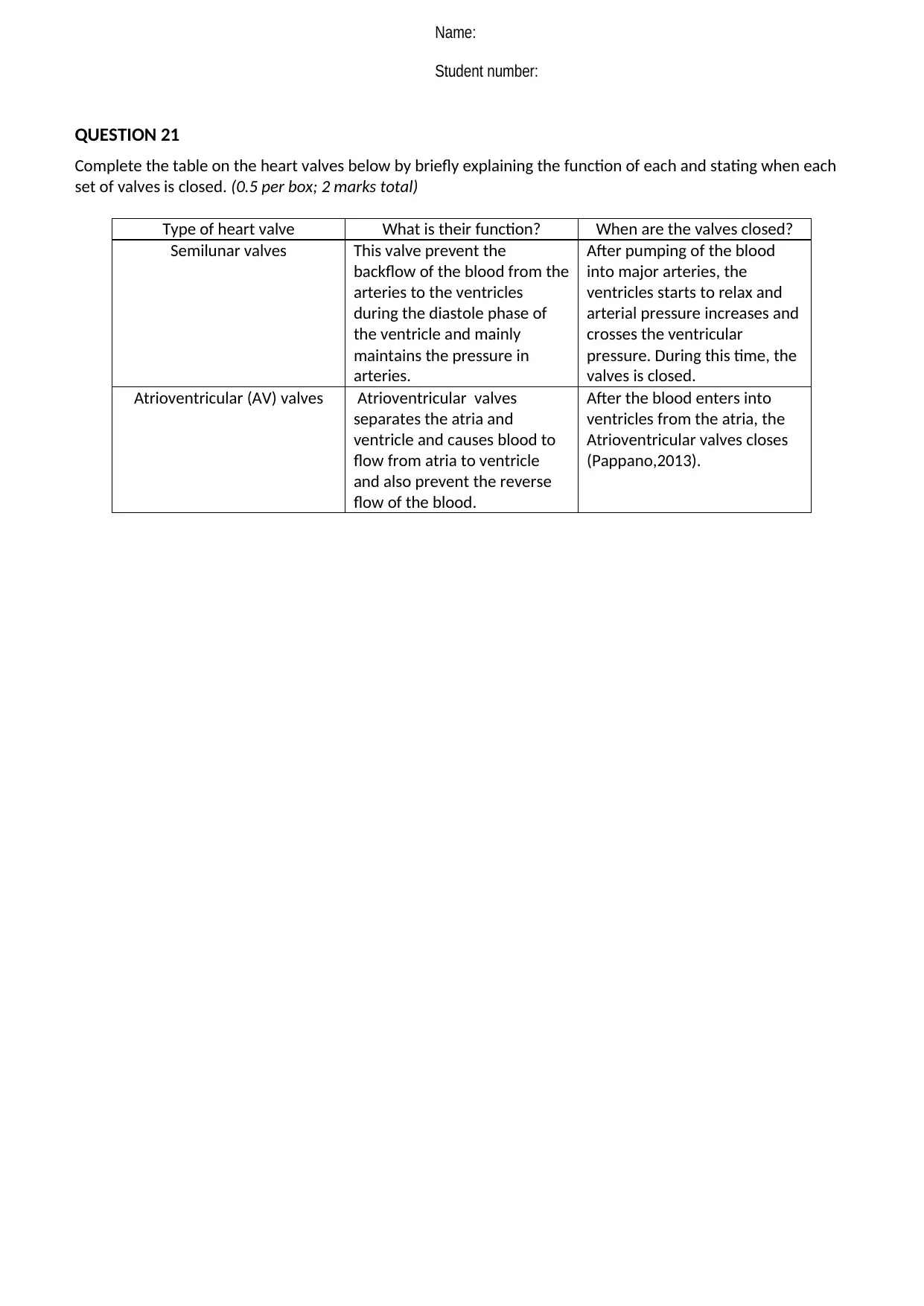
Name:
Student number:
QUESTION 21
Complete the table on the heart valves below by briefly explaining the function of each and stating when each
set of valves is closed. (0.5 per box; 2 marks total)
Type of heart valve What is their function? When are the valves closed?
Semilunar valves This valve prevent the
backflow of the blood from the
arteries to the ventricles
during the diastole phase of
the ventricle and mainly
maintains the pressure in
arteries.
After pumping of the blood
into major arteries, the
ventricles starts to relax and
arterial pressure increases and
crosses the ventricular
pressure. During this time, the
valves is closed.
Atrioventricular (AV) valves Atrioventricular valves
separates the atria and
ventricle and causes blood to
flow from atria to ventricle
and also prevent the reverse
flow of the blood.
After the blood enters into
ventricles from the atria, the
Atrioventricular valves closes
(Pappano,2013).
Student number:
QUESTION 21
Complete the table on the heart valves below by briefly explaining the function of each and stating when each
set of valves is closed. (0.5 per box; 2 marks total)
Type of heart valve What is their function? When are the valves closed?
Semilunar valves This valve prevent the
backflow of the blood from the
arteries to the ventricles
during the diastole phase of
the ventricle and mainly
maintains the pressure in
arteries.
After pumping of the blood
into major arteries, the
ventricles starts to relax and
arterial pressure increases and
crosses the ventricular
pressure. During this time, the
valves is closed.
Atrioventricular (AV) valves Atrioventricular valves
separates the atria and
ventricle and causes blood to
flow from atria to ventricle
and also prevent the reverse
flow of the blood.
After the blood enters into
ventricles from the atria, the
Atrioventricular valves closes
(Pappano,2013).
Secure Best Marks with AI Grader
Need help grading? Try our AI Grader for instant feedback on your assignments.
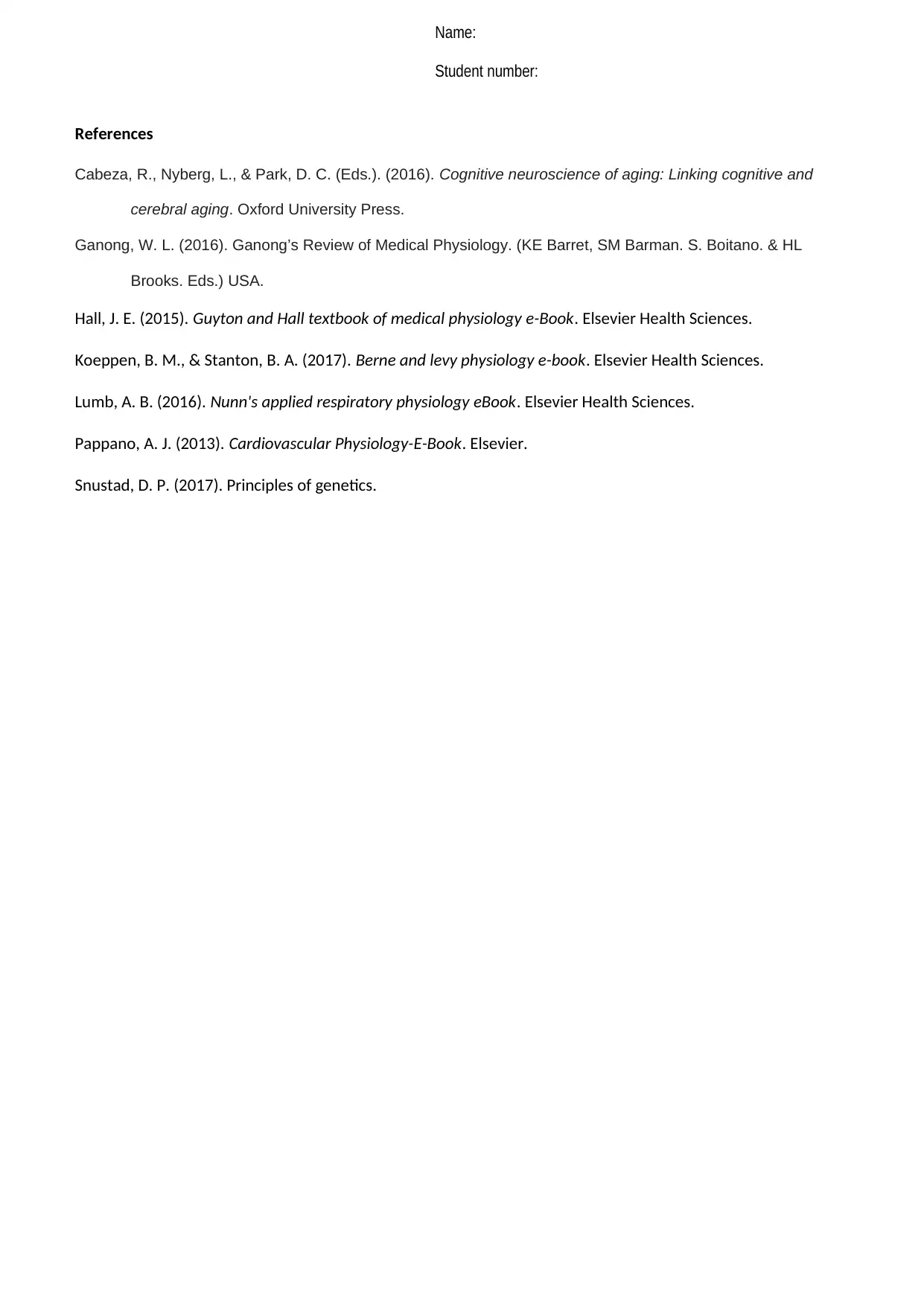
Name:
Student number:
References
Cabeza, R., Nyberg, L., & Park, D. C. (Eds.). (2016). Cognitive neuroscience of aging: Linking cognitive and
cerebral aging. Oxford University Press.
Ganong, W. L. (2016). Ganong’s Review of Medical Physiology. (KE Barret, SM Barman. S. Boitano. & HL
Brooks. Eds.) USA.
Hall, J. E. (2015). Guyton and Hall textbook of medical physiology e-Book. Elsevier Health Sciences.
Koeppen, B. M., & Stanton, B. A. (2017). Berne and levy physiology e-book. Elsevier Health Sciences.
Lumb, A. B. (2016). Nunn's applied respiratory physiology eBook. Elsevier Health Sciences.
Pappano, A. J. (2013). Cardiovascular Physiology-E-Book. Elsevier.
Snustad, D. P. (2017). Principles of genetics.
Student number:
References
Cabeza, R., Nyberg, L., & Park, D. C. (Eds.). (2016). Cognitive neuroscience of aging: Linking cognitive and
cerebral aging. Oxford University Press.
Ganong, W. L. (2016). Ganong’s Review of Medical Physiology. (KE Barret, SM Barman. S. Boitano. & HL
Brooks. Eds.) USA.
Hall, J. E. (2015). Guyton and Hall textbook of medical physiology e-Book. Elsevier Health Sciences.
Koeppen, B. M., & Stanton, B. A. (2017). Berne and levy physiology e-book. Elsevier Health Sciences.
Lumb, A. B. (2016). Nunn's applied respiratory physiology eBook. Elsevier Health Sciences.
Pappano, A. J. (2013). Cardiovascular Physiology-E-Book. Elsevier.
Snustad, D. P. (2017). Principles of genetics.
1 out of 11
Related Documents
Your All-in-One AI-Powered Toolkit for Academic Success.
+13062052269
info@desklib.com
Available 24*7 on WhatsApp / Email
![[object Object]](/_next/static/media/star-bottom.7253800d.svg)
Unlock your academic potential
© 2024 | Zucol Services PVT LTD | All rights reserved.





